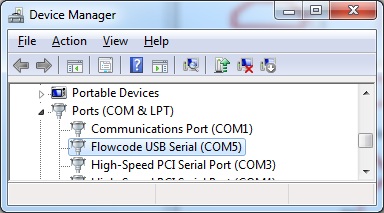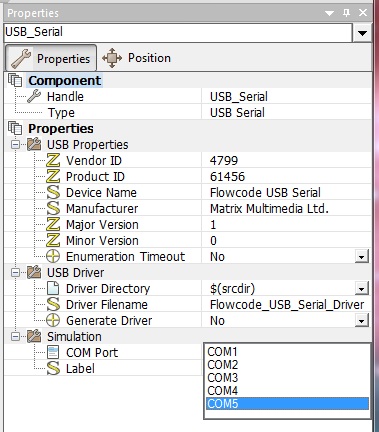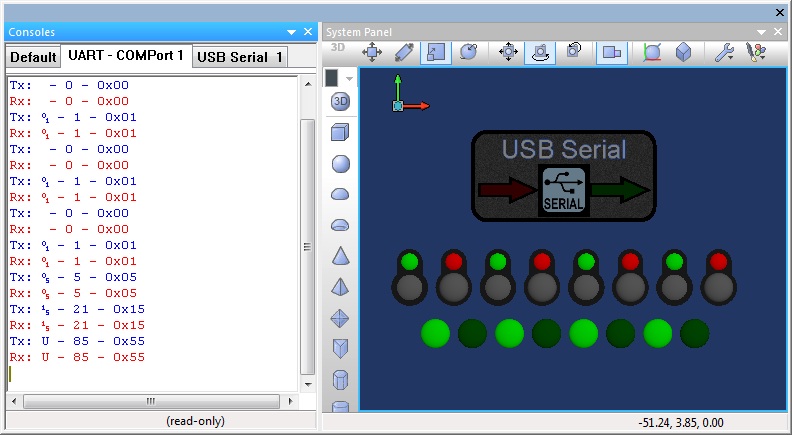Difference between revisions of "Component: USB Serial (Comms: USB)"
(XML import BR) |
|||
| Line 30: | Line 30: | ||
Here is a signed version of the USB Serial device driver using the default VID/PID properties. | Here is a signed version of the USB Serial device driver using the default VID/PID properties. | ||
| − | + | {{Zip|USBSerial_Driver.zip|USB Serial Driver}} | |
Revision as of 14:19, 27 August 2019
| Author | Matrix Ltd. |
| Version | 1.6 (Development) |
| Category | Comms: USB |
Contents
 USB Serial component
USB Serial component
Component to create and communicate using a standard CDC type COM port. Compatible with simulation and USB enabled microcontroller devices PIC/dsPIC/AVR.
Examples
The PIC based ECIOs or MIAC are good targets for USB as they do not have any additional configuration setting that need to be setup to allow the firmware to run correctly. For other targets you will have to setup the configuration correctly for your hardware to allow the USB to run correctly.
Here is an example file which waits for incoming data and then when valid data is received it displays this as a binary value onto the PortB pins before echoing back the data.
![]() USB Serial Simple Receive
The example requires a device driver to function correctly. The driver can be generated by selecting the USB Serial component on the System panel, Looking down the list of properties in the properties window, selecting the Generate Driver property and switching the setting to Yes. This will place the driver file into the same directory as the Flowcode fcfx project file is located.
USB Serial Simple Receive
The example requires a device driver to function correctly. The driver can be generated by selecting the USB Serial component on the System panel, Looking down the list of properties in the properties window, selecting the Generate Driver property and switching the setting to Yes. This will place the driver file into the same directory as the Flowcode fcfx project file is located.
Here is a signed version of the USB Serial device driver using the default VID/PID properties.
Here is an example file which is designed to run in simulation to communicate with the connected embedded device. The COM port property will have to match the COM port for the embedded device to allow the communications to work correctly. Alternatively a program like Hyperterminal or RealTerm can be used to generate the COM port data to send to the connected device.
![]() USB Serial Simulation
Finding which COM port has been allocated to your embedded device is as easy as opening the Windows device manager and looking under Ports.
USB Serial Simulation
Finding which COM port has been allocated to your embedded device is as easy as opening the Windows device manager and looking under Ports.
Assigning the correct COM port in the simulation needs to be done to allow the communications to work correctly.
Example of the data console with data being passed back and forth between the simulation and the embedded device.
Downloadable macro reference
SendString
Sends the specified data string to the host
Parameters
- <- STRING Data
- Data string to send to the host
- This parameter may be returned back to the caller
Return value
ReadString
Retreives a string from the incoming data buffer. If data is available then the macro will return straight away. If there is no data available then the macro waits up the the period specified by the timeout before returning the value 255.
Parameters
- BYTE Timeout_ms
- Length of time to wait before timing out
- BYTE Length
- Maximum number of bytes to try and read
Return value
SendByte
Sends the specified data byte to the host
Parameters
- BYTE data
- Data byte to send to the host
Return value
ReadByte
Retreives the byte from the incoming data buffer. If data is available then the macro will return straight away. If there is no data available then the macro waits up the the period specified by the timeout before returning the value 255.
Parameters
- BYTE Timeout_ms
- Number of milliseconds to wait before timing out
Return value
Initialise
Starts up the USB communications and attempts to enumerate.
Returns 0 for a successful startup or 255 for a enumeration timeout.
Parameters
- This macro has no parameters
Return value
Simulation macro reference
This component does not contain any simulation macros
Property reference
Vendor ID
This property is of type Signed integer and can be referenced with the variable name vendor_ID.
USB VID
Product ID
This property is of type Signed integer and can be referenced with the variable name product_ID.
USB PID
Device Name
This property is of type Line of text and can be referenced with the variable name dev_name.
USB Device Name
Manufacturer
This property is of type Line of text and can be referenced with the variable name dev_manufacturer.
USB Manufacturer
Major Version
This property is of type Signed integer and can be referenced with the variable name major_version.
USB Major Version Number
Minor Version
This property is of type Signed integer and can be referenced with the variable name minor_version.
USB Minor Version Number
Return Type
This property is of type Fixed list of ints and can be referenced with the variable name RETURN.
Specifies the way the receive function indicates a timeout.
8 Bit mode - Timeout is represented by the value 255.
16 Bit mode - Timeout is represented by the value 512 allowing the value 255 to represent valid data
Enumeration Timeout
This property is of type True or false and can be referenced with the variable name enumeration_tout.
Specifies if the enumeration (Initialise function) can timeout if taking too long.
Transmit Buffer Size
This property is of type Unsigned integer and can be referenced with the variable name TXBUFSZ.
Sets the size of the transmit buffer.
Recommended to be between 8 and 64 bytes.
Receive Buffer Size
This property is of type Unsigned integer and can be referenced with the variable name RXBUFSZ.
Sets the size of the receive buffer.
Recommended to be between 8 and 64 bytes.
Driver Directory
This property is of type Directory and can be referenced with the variable name driver_directory.
Directory to save the generated device driver .inf file
Driver Filename
This property is of type Line of text and can be referenced with the variable name driver_filename.
Filename to give to the generated driver file.
Generate Driver
This property is of type True or false and can be referenced with the variable name gen_driver.
Generates a driver file when set to Yes, Automatically jumps back to No when complete.
COM Port
This property is of type Fixed list of text and can be referenced with the variable name COM_port.
Hardware COM port to communicate with any connected USB serial devices or any other virtual COM ports.
Label
This property is of type Line of text and can be referenced with the variable name label.
Text displayed on the I/O flasher comms component.


